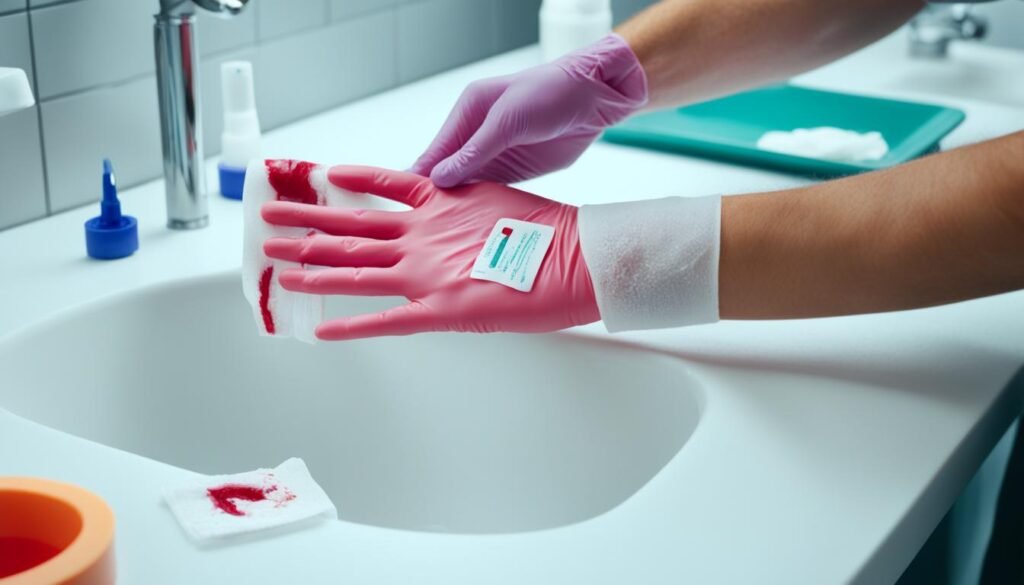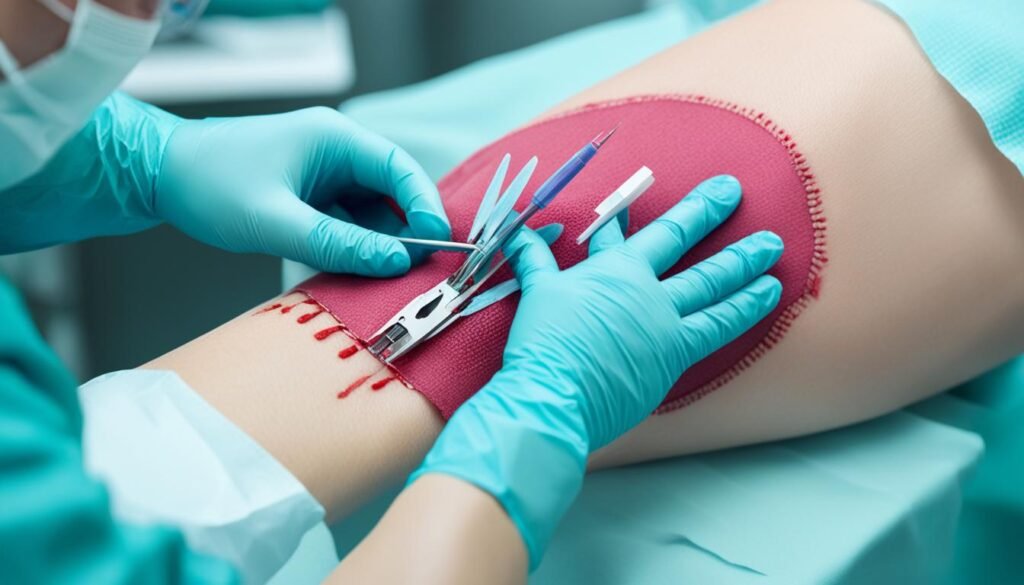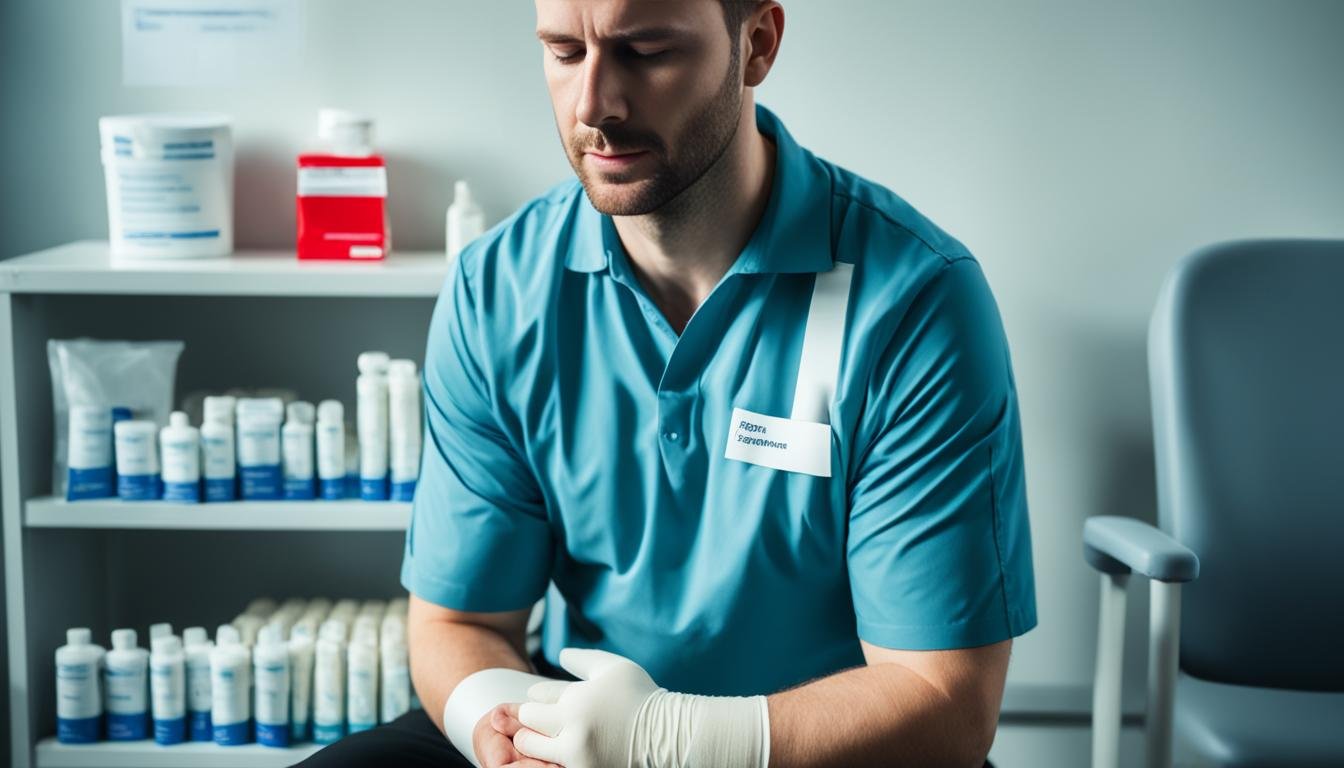Did you know that in the United States alone, over 30 million people seek medical treatment for lacerations and cuts each year?**Coping with Lacerations Cuts, Treatment for Lacerations, First Aid for Cuts, Dealing with Wounds, Healing Cuts Fast, Managing Skin Cuts, Ways to Handle Lacerations, Tips for Caring for Cuts, Coping with Minor Injuries**
Lacerations and cuts can happen to anyone, from a small kitchen mishap to a more serious accident. Knowing the different types of wounds, proper first aid, and treatment options is key. This knowledge helps with effective healing and reduces complications.
This article covers how to deal with lacerations and cuts. We’ll discuss recognizing injury types and providing the best care for quick recovery. By the end, you’ll know how to manage minor injuries well and help the healing process.
Key Takeaways:
- To cope with lacerations and cuts, it is important to understand the different types of wounds and injuries that can occur.
- Proper first aid techniques, such as cleaning the wound and applying direct pressure, can help prevent infection and promote healing.
- Treatment options for laceration repair range from adhesive strips to stitches and staples, depending on the severity and location of the wound.
- Home care practices, including keeping the wound clean and following medical instructions, are crucial for optimal healing.
- Knowing when to seek medical help for wounds is essential to prevent complications and ensure proper treatment.
Common Types of Injuries and Wounds
Injuries happen for many reasons, like accidents, falls, or even from a weapon. Wounds break the skin or other tissues in the body. We see cuts, scrapes, scratches, and punctures often. These can happen by accident or during medical care. It’s important to know about injuries and wounds to treat them right.
Accidents lead to many injuries. Falling, slipping, or tripping might cause fractures or cuts. Types of injuries from falls range from bruises to serious head injuries. Sports might bring sprained ankles, dislocated joints, or breaks. Hits or blunt forces from fights or car crashes can lead to bruises, breaks, or internal harm.
Wounds involve the breaking of the skin or tissues. Sharp objects can cause cuts or lacerations, tearing the skin. Rubbing against something rough leads to scrapes. Scratches are shallow cuts, often by nails. Punctures come from sharp objects like needles.
Wounds range from tiny to deep and severe. Common wounds like paper cuts or minor scrapes can be treated at home. But deeper cuts need a doctor’s care to avoid infection and heal right.
First Aid for Lacerations and Cuts
Knowing the right first aid for lacerations and cuts helps prevent infection. It also helps the wound heal faster. Here are the steps you should follow:
- Apply direct pressure to the wound using a clean cloth or gauze pad. This step helps stop the bleeding.
- Elevate the wound, if you can. This reduces blood flow and swelling.
- Clean the wound well with clean water or saline solution. Don’t use alcohol or hydrogen peroxide as they can harm tissues.
- Cover the wound with a sterile bandage. This keeps it safe from dirt and germs.
If the cut is deep or hard to clean, get medical help immediately. Also, see a doctor if the bleeding won’t stop or the injury was from a dirty object.
Learning basic first aid for cuts lets you handle minor injuries well. It also lowers the risk of problems.
“Prompt and proper first aid for lacerations and cuts is vital. It prevents infection and speeds up recovery.” – Dr. Emily Johnson, Emergency Medicine Specialist
Adopt these first aid methods to take good care of your wounds. This speeds up healing. Always get medical help when needed to avoid complications.

| Tips for First Aid | Benefits |
|---|---|
| Apply direct pressure | Stops bleeding and promotes clotting |
| Elevate the wound | Reduces blood flow and swelling |
| Clean the wound with water | Prevents infection and removes debris |
| Cover with sterile bandage | Protects from dirt and bacteria |
Using these suggested first aid methods, you manage your cut or laceration well. This makes sure your wound is cared for properly, helping it to heal better.
Treatment Options for Laceration Repair
Laceration repair needs the wound to be cleaned, prepared, and closed well. This helps it heal right. What method to use depends on the injury’s severity and where it is. Here are some common ways to fix lacerations:
Dermabond
Dermabond is a medical glue that holds the wound’s edges together. It works well for small and medium lacerations. This glue forms a barrier over the wound. This lowers the chance of infection and removes the need for stitches. Over time, the glue dissolves as the wound heals.
Steristrips
Steristrips are sticky strips that keep a wound’s edges together. They’re for small, clean cuts not in areas of high tension. Steristrips support the wound and aid in healing. They’re often used with other methods or as a stitch alternative.
Stitches
Stitches, or sutures, are a classic way to repair lacerations. A needle and thread sew the wound edges together. This method is good for deep or large cuts, including those under tension. The stitches’ type and size will depend on the wound. They’re usually removed by a healthcare professional after some time, allowing the wound to heal.
Staples
Staples are metal clips that close wounds, especially in low-tension areas like the scalp. They’re fast and effective for excellent wound closure. Staples are often used for big cuts or when strong support is needed. A healthcare professional will remove them once the wound has healed.
Hair Tying for Scalp Lacerations
For scalp lacerations, tying the hair can hold the wound edges together. Rubber bands or glue can secure the hair over the wound. This provides gentle pressure to hold the edges together. Often, this is used with other methods for scalp cuts.
Note: A healthcare professional should choose the right laceration treatment. It’s crucial to get medical help to evaluate and manage the wound properly.
| Treatment Options | Uses | Advantages | Disadvantages |
|---|---|---|---|
| Dermabond | Small to medium-sized clean lacerations | Minimizes infection risk, no stitches required | Not suitable for deep or high tension wounds |
| Steristrips | Small, clean lacerations | Supports wound healing, non-invasive | May not be suitable for all lacerations |
| Stitches | Deeper or larger lacerations, wounds under tension | Provides strong wound closure | May require removal by a healthcare professional |
| Staples | Large lacerations, low tension areas | Quick and easy application | Requires removal by a healthcare professional |
| Hair Tying for Scalp Lacerations | Scalp lacerations | Promotes wound closure | May not be suitable for all scalp lacerations |

Home Care for Wound Healing
Proper home care is crucial for promoting wound healing. When caring for wounds at home, it’s important to keep the wound clean. This helps prevent infection and aids the healing process. Clean the wound gently using mild soap and water.
Pat the wound dry with a clean towel after cleaning it. Avoid scrubbing the wound to prevent further damage.
After cleaning, apply a sterile bandage to protect the wound. Change the bandage often, or as your doctor advises. This keeps the wound clean, aiding healing and preventing infection.
It’s important to follow any specific instructions your healthcare provider gives you. They may suggest using certain antibiotic ointments or special dressings. Make sure you follow these instructions and use the recommended products as directed.
A healthcare professional may offer advice on managing pain from the wound. They might prescribe antibiotics to prevent or treat infection, along with pain medication. Always take these medications as prescribed.
To support the healing process, avoid activities that could disturb the healing. Avoid heavy lifting or intense exercise. Eating a balanced diet rich in nutrients also promotes healing.
Remember, every wound is different, needing individualized care. If you’re unsure about caring for your wound at home, talk to a healthcare professional. They can offer the best guidance and support.
Tips for Wound Healing at Home
- Follow proper hygiene practices: Wash your hands well before touching the wound or applying bandages.
- Avoid picking or scratching the wound: This can worsen the wound and slow healing.
- Keep the wound moist: Put a thin layer of petroleum jelly or a suitable healing ointment on the wound to keep it moist.
- Protect the wound from sunlight: Use sunscreen or cover it with clothing to avoid sunburn and reduce scarring.
- Stay hydrated: Drinking plenty of fluids is vital for overall healing and keeps the body hydrated.
When to Seek Medical Help for Wounds
Many wounds can be treated at home, but some need a doctor’s care. If the wound is deep, shows bone or organs, or won’t stop bleeding after pressing hard, get immediate medical attention.
Wounds that are longer than half an inch might need stitches. Also, see a doctor if a wound comes from an animal bite, a dirty item, or something rusty. This helps avoid infection.
Watch out for signs that the wound is getting worse. These include more pain, swelling, stuff coming out of it, or a fever. If you see any of these, go to the doctor.
If a wound isn’t healing after a month, or you’re worried about it, talk to a doctor or a surgeon. They can offer advice to help it heal right.
When to Seek Medical Help for Wounds – Summary
It’s key to know when to get medical help for wounds. If a wound is deep, reveals bone or organs, keeps bleeding, or is over 1/2 inch long, see a doctor right away. You should also get help for wounds from bites, dirty, or rusty items. Signs like more pain, redness, pus, or fever mean you should visit a doctor. If healing isn’t happening after 30 days, or you’re worried, seek more advice or see a surgeon.
| Situation | When to Seek Medical Help |
|---|---|
| Deep wound | Exposing bone or organs |
| Significant and uncontrolled bleeding | Continues even after applying pressure |
| Wound longer than 1/2 inch | Possible need for stitches |
| Wounds caused by animal or human bites, dirty objects, or rusty objects | Evaluation by a healthcare professional |
| Worsening symptoms | Increased pain, redness, discharge, or fever |
| Wound not showing signs of healing after 30 days | Second opinion or consultation with a surgeon |
Conclusion
Dealing with cuts and scrapes means knowing the various kinds of injuries. It also means giving the right first aid. And, when needed, getting the right treatment is key.
By doing these things, you help wounds heal better. You also reduce scars and speed up recovery. It’s crucial to take care of wounds well.
Always seek medical help when it’s needed. This ensures the best healing. It also lowers the chance of any problems.

